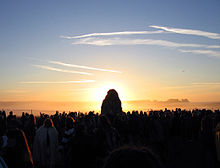
The Solar New Year is the beginning of the solar calendar year. This event is observed at different times of year and with varying practices in cultures across the globe. The most common bases chosen to begin a new calendar year are the winter solstice, summer solstice, the spring equinox and the autumnal equinox. South and South-east Asian solar calendars are more formally linked to astronomical events.
Contents
Some of the more widely known solar new year celebrations include:
- Enkutatash (Ethiopian calendar): about ten days before the autumnal equinox
- January 1 in the Gregorian and Julian calendars (same number, different days): at present [a] about twelve and twenty-five days respectively after the northern winter solstice.
- Iranian New Year (Nowruz) : precisely the northern spring equinox
The various solar new years celebrated in South/SE Asia, whose new year is determined by the position of the Sun relative to the constellation of Aries, [1] such as
- Vishu : Vishu falls on the first day of the month of Medam in the Malayalam Calendar
- Cambodian New Year: about six or seven days before the northern spring equinox
- Tamil New Year (Tamil : தமிழ் புத்தாண்டு, romanized: Puttāṇṭu, lit. 'new year'): about 24 or 25 days after the northern spring equinox
- Vaisakhi: about 24 or 25 days after the northern spring equinox
- Pohela Boishakh (Bengali calendar): about 24 or 25 days after the northern spring equinox
- Pana Sankranti (Odia: ପଣା ସଂକ୍ରାନ୍ତି): about 24 or 25 days after the northern spring equinox.